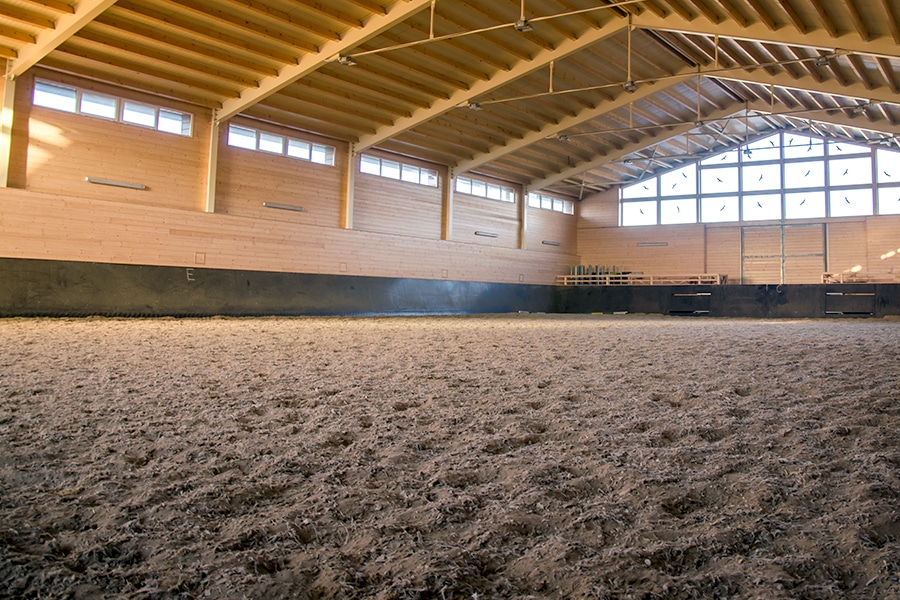An excellent arena sets your horses up for success. Creating a proper base, subbase, and surface helps stabilize and cushion your arena.
Looking for more information on your horse arena construction? Here’s everything you need to know about creating a high-quality horse arena.
Footing Layer
There is no one size fits all answer to finding the best footing layer. The right footing solution for your horse arena depends on what you intend to use your arena for, local materials, and more.
If your arena will mainly be used for dressage, you’ll have different footing needs than an arena primarily used for jumping. Try different footing options to see what works best for you and your horse.
Common Footing Materials
The surface layer of an arena is a combination of sand and footing additives. There are different footing additives for different budgets, different arena functions, and different climates. Here are some of the most common types of horse arena footing materials.
Sand
Sand is a common material for horse arenas of all types. It is extremely versatile and can be used in both indoor and outdoor arenas. Depending on your arena’s needs, you can choose different grain sizes and shapes.
For most arenas, angular and hard sand is the best option. Angular sand is naturally occurring sand that has not been ground into rounded shapes.
There are also different size options for arena sand. Usually, sand for horse arenas ranges between .05mm and 2mm.
Riding arenas are better suited for coarse sand with larger grain sizes. Keep in mind that your horse will break down sand grains into smaller particles over time. For dressage arenas, finer sand is a better option since cushioning and support are higher priorities.
Wood Products
Another inexpensive option for your riding arena surface is wood products. They can be used instead of sand for your primary arena surface material. Wood materials are typically less expensive than sand, but can be a less effective footing option. Wood chips will also require more maintenance than other types of footing, they create more dust and need more frequent watering.
If you’re looking to purchase wood products for your arena, find a manufacturer that specializes in horse arenas. Some woods are dangerous for horses and larger wood chips may not be suitable for riding.
Rubber and Yoga Mats
Rubber is another popular option for arena footing materials. While rubber footing products can be used as a primary footing solution, they are best used as a footing additive. FoamFooting™ is a particularly effective yoga mat and rubber-based footing additive.
Rubber provides excellent cushioning and compaction for your horse. It is also less prone to shifting as sand and other alternative footing options.
Synthetic Fibers
Man-made textiles can be a good footing additive for your horse. They are made of many different types of fabrics and usually contain plastics. Like with other footing solutions, there is no one synthetic fiber product best for every arena. Synthetic fibers are usually a more inexpensive footing additive.
Fiber Footing
Fiber footing products such as Noviun are higher-quality and more eco-friendly footing additives. They provide excellent cushioning and retain water extremely well. Made from natural materials, they also work well when blended with other footing materials.
Geotextile Fabric
Below the surface layer of an arena is the arena base. This layer needs to be separated from the footing layer to prevent materials from mixing together. Geotextile fabric is a permeable material used to separate horse arena layers. There are two types of geotextile fabric: woven and non-woven.
Compacted Stone Base
Creating a high-quality arena starts with its foundation. The base layer of any arena needs to be solid and stable to provide support for your horses. This layer is usually made from compacted angular stones.
Indoor vs Outdoor Base
Bases for indoor and outdoor arenas serve the same function: creating a solid foundation to protect your horse. Any uneven or shifting material will lower the quality of your arena and increase your horse’s risk of injury.
However, there are some additional considerations when choosing a base for an outdoor riding arena. Most notably, outdoor arenas need to be more concerned with drainage solutions. With their exposure to the elements and rainfall, outdoor arenas are more prone to flooding. Bases for outdoor arenas need to be permeable to allow water to flow through them.
Drainage Layer
The drainage layer of your horse arena is a crucial component. Poor drainage can cause frequent flooding of your arena. There are several different types of arena drainage solutions, but French drains are the most common.
BaseCore™ is another drainage option. The geocells provide excellent stability and structure while allowing water to easily pass through.
Contact Us
Have questions about your horse arena? Performance Footing has experts on hand to address any of your arena questions. Send us a note through our website or give us a call at 877-835-0878.
